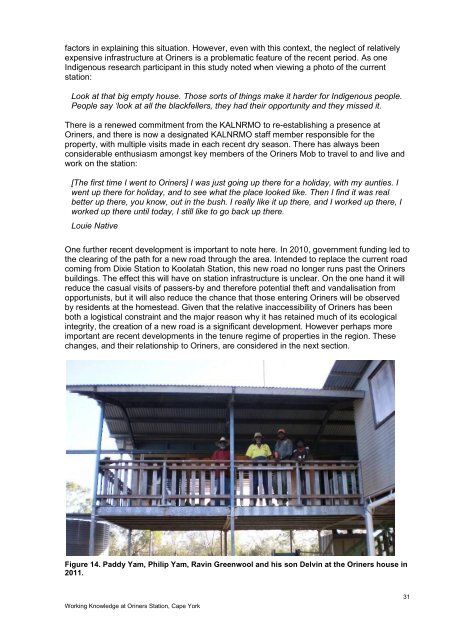WfHC - cover page (not to be used with pre-printed report ... - CSIRO
WfHC - cover page (not to be used with pre-printed report ... - CSIRO
WfHC - cover page (not to be used with pre-printed report ... - CSIRO
You also want an ePaper? Increase the reach of your titles
YUMPU automatically turns print PDFs into web optimized ePapers that Google loves.
fac<strong>to</strong>rs in explaining this situation. However, even <strong>with</strong> this context, the neglect of relatively<br />
expensive infrastructure at Oriners is a problematic feature of the recent period. As one<br />
Indigenous research participant in this study <strong>not</strong>ed when viewing a pho<strong>to</strong> of the current<br />
station:<br />
Look at that big empty house. Those sorts of things make it harder for Indigenous people.<br />
People say „look at all the blackfellers, they had their opportunity and they missed it.<br />
There is a renewed commitment from the KALNRMO <strong>to</strong> re-establishing a <strong>pre</strong>sence at<br />
Oriners, and there is now a designated KALNRMO staff mem<strong>be</strong>r responsible for the<br />
property, <strong>with</strong> multiple visits made in each recent dry season. There has always <strong>be</strong>en<br />
considerable enthusiasm amongst key mem<strong>be</strong>rs of the Oriners Mob <strong>to</strong> travel <strong>to</strong> and live and<br />
work on the station:<br />
[The first time I went <strong>to</strong> Oriners] I was just going up there for a holiday, <strong>with</strong> my aunties. I<br />
went up there for holiday, and <strong>to</strong> see what the place looked like. Then I find it was real<br />
<strong>be</strong>tter up there, you know, out in the bush. I really like it up there, and I worked up there, I<br />
worked up there until <strong>to</strong>day, I still like <strong>to</strong> go back up there.<br />
Louie Native<br />
One further recent development is important <strong>to</strong> <strong>not</strong>e here. In 2010, government funding led <strong>to</strong><br />
the clearing of the path for a new road through the area. Intended <strong>to</strong> replace the current road<br />
coming from Dixie Station <strong>to</strong> Koolatah Station, this new road no longer runs past the Oriners<br />
buildings. The effect this will have on station infrastructure is unclear. On the one hand it will<br />
reduce the casual visits of passers-by and therefore potential theft and vandalisation from<br />
opportunists, but it will also reduce the chance that those entering Oriners will <strong>be</strong> observed<br />
by residents at the homestead. Given that the relative inaccessibility of Oriners has <strong>be</strong>en<br />
both a logistical constraint and the major reason why it has retained much of its ecological<br />
integrity, the creation of a new road is a significant development. However perhaps more<br />
important are recent developments in the tenure regime of properties in the region. These<br />
changes, and their relationship <strong>to</strong> Oriners, are considered in the next section.<br />
Figure 14. Paddy Yam, Philip Yam, Ravin Greenwool and his son Delvin at the Oriners house in<br />
2011.<br />
Working Knowledge at Oriners Station, Cape York<br />
31
















